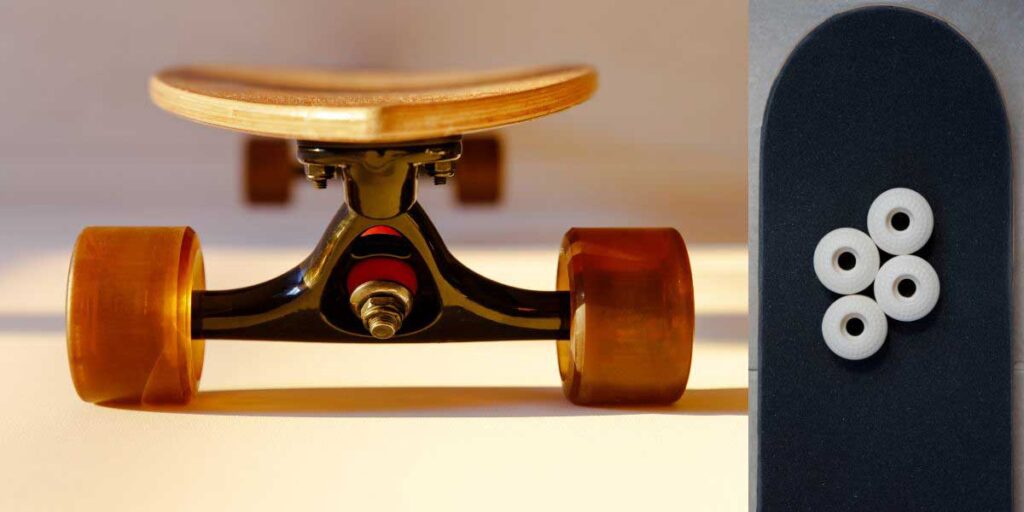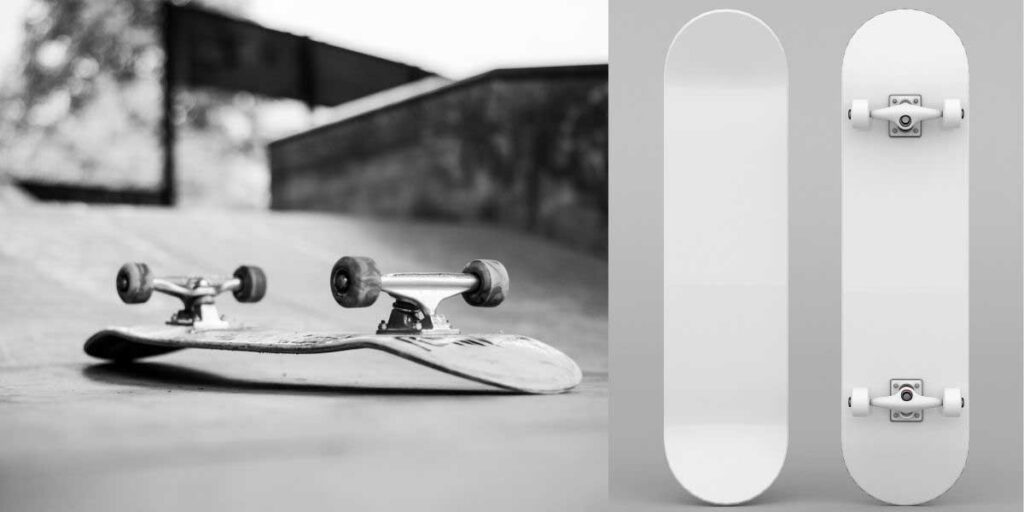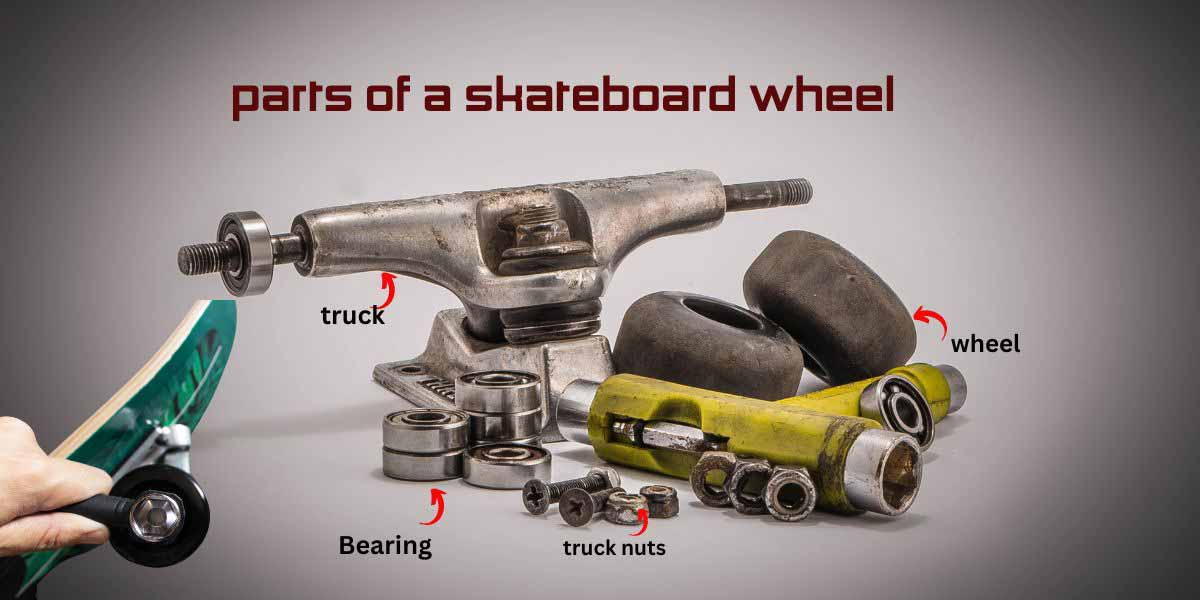The main parts of a skateboard wheel are the core, urethane, and bearings. The Skateboard wheel part plays an important role in performance.
Skateboard wheels are essential for a smooth and enjoyable skate ride. Made from durable urethane, they come in various sizes and hardness levels. The core, usually plastic, provides structure and houses the bearings. The outer wheel ensures grip and durability on different surfaces.
The bearing seat holds the bearings that allow the wheel to spin freely. Understanding these parts helps you make informed decisions for your skateboard setup.
Anatomy of a Skateboard Wheel
A skateboard wheel might look simple, but it has several key components. Here’s a quick overview:
- Urethane: This is the outer layer of the wheel.
- Core: The inner structure that supports the urethane.
- Bearings: Small metal balls that allow the wheel to spin.
Let’s break down each part in more detail.
Urethane

What is Urethane?
Urethane is a type of plastic known for its durability and flexibility. It’s the main material used in skateboard wheels.
Why Urethane Matters
The hardness of urethane affects how your skateboard performs. Softer urethane offers more grip, making it better for rough surfaces. Harder urethane provides more speed and is ideal for smooth surfaces like skate parks.
Durometer Scale
Wheel hardness is measured on the durometer scale, usually ranging from 78A (soft) to 101A (hard). Here’s a quick guide:
- 78A – 87A: Soft wheels for rough terrain.
- 88A – 95A: Medium wheels for street and rough surfaces.
- 96A – 101A: Hard wheels for smooth surfaces and tricks.
Core And Hub
The core and hub are crucial parts of a skateboard wheel. They affect the wheel’s performance, durability, and ride quality.
Types of Cores
- Solid Core: Made from one piece of material, offering stability.
- Hollow Core: Lightweight and good for tricks.
Core Materials
The core of a skateboard wheel is the inside part that holds the bearings. Cores are typically made from different materials. Each material offers unique benefits.
- Plastic Cores: Lightweight and affordable. Best for beginners.
- Aluminum Cores: Strong and durable. Suitable for advanced skaters.
- Fiberglass Cores: Provides a balance of strength and weight. Ideal for speed.
Choosing the right core material can enhance your skating experience. Consider your skating skill level and style.
Role In Stability
The core and hub play a significant role in wheel stability. A strong core ensures that the wheel maintains its shape under pressure. Moreover, this stability is vital for smooth rides and sharp turns.
Here are some key points:
- Durability: Strong cores last longer and perform better.
- Weight Distribution: Even weight distribution improves balance.
- Shock Absorption: Quality cores reduce vibrations for a smoother ride.
Investing in wheels with a good core and hub can make a big difference. It enhances overall skating performance and safety.
Bearings

What are Bearings?
Bearings are small, metal balls inside the core of the wheel. They allow the wheel to spin smoothly.
Parts of a Bearing
- Shield: Protects the bearing.
- Ball: The actual balls that roll inside.
- Race: The track the balls roll on.
- Cage: Holds the balls in place.
Bearing Ratings
The ABEC system rates bearings. Higher ratings (ABEC 5, 7, 9) mean smoother and faster rides. However, many skaters prefer non-ABEC-rated bearings designed specifically for skateboarding.
Maintaining Bearings
Clean your bearings regularly to keep them spinning smoothly. Remove the shield, clean with solvent, dry, and re-lubricate.
| Factor | Impact |
| Alignment | Smooth rotation, reduced wear |
| Misalignment | Wobbling, uneven wear, slower speed |
In summary, the bearings are crucial for performance. Pay attention to this small but vital part of your skateboard wheels.
Wheel Material
The material of a skateboard wheel can impact performance. It affects the ride quality and durability. Most skateboard wheels are made from polyurethane. This material is known for its resilience and grip.
Polyurethane Composition
Polyurethane is a flexible plastic and provides a smooth ride. The composition can vary in hardness. Skateboard wheels are rated on a durometer scale. Softer wheels offer better grip. On the other hand, harder wheels provide more speed. However, the choice depends on your riding style.
- Softer Wheels: Better for rough surfaces and cruising.
- Harder Wheels: Ideal for tricks and smooth surfaces.
Durability Factors
Durability is key for skateboard wheels. Polyurethane wheels are durable. They resist wear and tear. Several factors affect durability. These include the wheel’s hardness and usage frequency.
| Factor | Impact on Durability |
| Hardness | Harder wheels last longer. |
| Surface | Smoother surfaces reduce wear. |
| Riding Style | Aggressive riding wears wheels faster. |
Wheel maintenance can extend life. That’s why clean wheels regularly and avoid riding on rough surfaces. Check for cracks and replace worn wheels.
Wheel Diameter
The wheel diameter of a skateboard plays a crucial role in its performance. It directly affects the speed, control, and overall riding experience. The different aspects of wheel diameter can help you choose the right one.
Size Variations
Skateboard wheels come in various sizes. The sizes are typically measured in millimeters (mm). The most common sizes range from 50mm to 75mm. Smaller wheels, around 50mm to 54mm, are great for street skating and technical tricks. Also, they provide more control and are lighter.
On the other hand, larger wheels, like 60mm to 75mm, are ideal for cruising and downhill skating. They offer more stability and speed. These wheels are heavier but provide a smoother ride over rough surfaces.
| Wheel Diameter | Best Use |
| 50mm – 54mm | Street Skating, Technical Tricks |
| 55mm – 59mm | All-Around Skating |
| 60mm – 75mm | Cruising, Downhill |
Impact On Performance
The diameter of your skateboard wheels impacts your ride’s speed and control. Smaller wheels accelerate faster but have a lower top speed. They are perfect for street skating where quick turns and tricks are common.
Larger wheels maintain higher speeds and roll over obstacles easily. These types of wheels are excellent for long-distance cruising and downhill riding. The increased diameter also provides better shock absorption and makes your ride smoother.
Choosing the right wheel diameter depends on your skating style and preferred terrain. Consider these factors to enhance your skateboarding experience.
- For technical tricks: Choose smaller wheels (50mm – 54mm).
- For cruising and downhill: Opt for larger wheels (60mm – 75mm).
Wheel Hardness
Wheel hardness is crucial for skateboarding. It affects your ride’s smoothness and grip. The wheel hardness helps you choose the right wheels for your style.
Durometer Scale
Wheel hardness is measured using the Durometer Scale. The scale ranges from 1A to 100A. Higher numbers mean harder wheels. Softer wheels have lower numbers.
Durometer RatingWheel Hardness78A – 87ASoft88A – 95AMedium96A – 100AHard
Suitability For Different Terrains
Different terrains require different wheel hardness. Here’s a guide:
- Soft Wheels (78A – 87A): Best for rough surfaces. Great for cruising and longboarding.
- Medium Wheels (88A – 95A): Suitable for street and park skating. Offers a balance between grip and speed.
- Hard Wheels (96A – 100A): Ideal for smooth surfaces like skateparks. Provides more speed and less grip.
Choosing the right wheel hardness increases your skateboarding experience. Always consider the terrain and your style.
Wheel Shape
The shape of a skateboard wheel matters a lot. It influences your ride and trick performance. Each shape gives a distinct feel. They enhance stability, speed, and control.
Profile Types
Skateboard wheels come in various profile types. Each type is made for specific purposes. Below are some common wheel profiles:
| Profile Type | Description | Best For |
| Round Edge | These wheels have rounded edges. | Great for street skating. |
| Square Edge | These wheels have sharp edges. | Ideal for cruising and stability. |
| Conical | These wheels are cone-shaped. | Good for technical tricks. |
Influence On Ride Quality
Wheel shape can impact your riding experience. Round edges offer smooth turns, while square edges provide more grip and stability. Conical wheels allow precise movements.
- Round Edge: Smooth, easy to turn.
- Square Edge: More grip, less sliding.
- Conical: Good for technical tricks, easy to control.
Pick a wheel shape that suits your skateboarding style. This will boost your performance and fun.
Maintenance Tips
Taking care of your skateboard wheels is essential for a smooth ride. Regular maintenance helps your wheels as well as skateboards last longer. Here are key tips for keeping your skateboard wheels in great shape.
Cleaning And Care
Regular cleaning is crucial for your skateboard wheels. Dirt and debris can affect performance. Follow these steps to clean your wheels:
- Remove the wheels from the skateboard.
- Use a cloth to wipe off loose dirt.
- Soak the wheels in warm soapy water.
- Scrub gently with a soft brush.
- Rinse and dry thoroughly.
Make sure to check the bearings as well. Clean and lubricate them if needed. This ensures a smooth ride and prolongs wheel life.
When To Replace Wheels
Knowing when to replace your wheels is important. Worn-out wheels can lead to accidents. Here are signs your wheels need replacing:
- Flat spots on the wheels.
- Cracks or chips on the surface.
- Noticeable decrease in performance.
- Excessive wobbling when riding.
If you notice any of these signs, it’s time for new wheels. Regularly inspect your wheels for any damage.
Frequently Asked Questions
What are skateboard wheels made of?
Skateboard wheels are primarily made of urethane.
How do I choose the right hardness for my wheels?
Consider your riding style and surface type. Softer wheels (78A – 87A) are good for rough terrain, while harder wheels (96A – 101A) are better for smooth surfaces.
Why do my skateboard wheels wear unevenly?
Uneven wear can be caused by improper weight distribution or not rotating your wheels regularly.
Can I use any bearings for my skateboard wheels?
It’s best to use bearings designed for skateboarding. Higher ABEC ratings mean smoother rides, but skate-specific bearings often perform better.
How often should I clean my skateboard bearings?
Clean your bearings every few months or whenever they feel gritty.
What are skateboard parts?
A skateboard consists of a deck, trucks, wheels, bearings, grip tape, and hardware. Each part plays a crucial role.
What are the things that hold the wheels on a skateboard called?
The parts that hold the wheels on a skateboard are called trucks. They connect the wheels to the deck.
What is inside a skateboard wheel?
A skateboard wheel contains a urethane exterior and an inner core. The core often houses steel or ceramic bearings.
What is every part of a skateboard truck?
A skateboard truck consists of a hanger, baseplate, kingpin, bushings, axle, and pivot cup.
Conclusion
Knowing the parts of a skateboard wheel can elevate your riding experience. From the core to the durometer, each component plays a role. Choosing the right wheels can improve performance and safety. So, always consider your style and needs. This knowledge helps you make better choices. It leads to a smoother and more enjoyable ride.

